
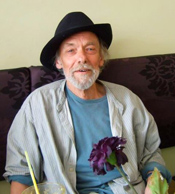 Graham in a cafe in Bideford, Devon, 2010, photographed by his eldest daughter, singer-songwriter Judith Christie.
Graham in a cafe in Bideford, Devon, 2010, photographed by his eldest daughter, singer-songwriter Judith Christie.
 Graham (back right) in school photo.
Graham (back right) in school photo.
Graham Kingsley Brown was a truly diverse and entirely self-educated artist; an avid scholar of art history and poetry, he produced works entirely from his imagination.
Early Life
Graham was born in Hull, Yorkshire on 3rd May 1932, the youngest of four children, to Betty, of part-Irish descent, and Lesley Brown. As a child, he was evacuated to a large manor house (believed to be no. 7 Hengate) in Beverley during the second world war with his brother Gordon after their family home in Summergangs Road was destroyed by bombing in 1939. He later won a scholarship to Beverley Grammar school, excelling in literature and sports. In his youth, Graham devised poetic thoughts and phrases, and drew a self-portrait in the style of El-Greco: the first stirrings of an interest in art.
Family: Scotland, Lincolnshire, Ireland
On leaving school - whilst really wishing to be an artist - he nonetheless joined the civil service, working in the customs office in Hull, where he met his Scottish wife to be, Elizabeth. They moved to Edinburgh, were married in 1956 and had their first child, Judith, in 1959. Adventurous and bohemian in spirit, they took up the role of wardens at the remote Broadmeadows Youth Hostel in the Borders, where Sophie was born in 1961, and Graham began to write short stories. Graham appears in this short film (at 12:50 - 13:09) from 1962 called "As Long as You're Young", at Broadmeadows - which we only discovered in 2023.
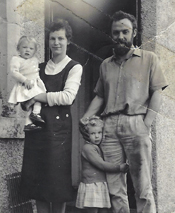 From right: Graham, Judith, Elizabeth, Sophie at Broadmeadows Youth Hostel in the Scottish borders, 1962
From right: Graham, Judith, Elizabeth, Sophie at Broadmeadows Youth Hostel in the Scottish borders, 1962
The family then moved to Barnoldby le Beck in Lincolnshire, while Graham worked for the National Assistance Board. Annabel, their third daughter was born in 1962. In 1964, searching for something out of the ordinary, they emigrated to South West Cork, Ireland, starting by working in the Pottery ("Gurteenakilla" run by Frank and Christa Reichel) in February 1965. They lived simply but somewhat isolated, in a farmhouse in the unspoilt countryside at Coosane, before moving into the small village of Ballydehob nearby.
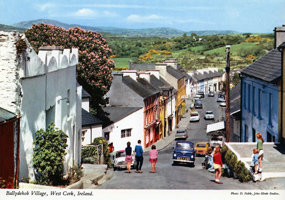 Ballydehob village, South West Ireland: a postcard which actually has (from right to left) Graham's daughters Judith, Una and Sophie in the picture c. 1969.*
Ballydehob village, South West Ireland: a postcard which actually has (from right to left) Graham's daughters Judith, Una and Sophie in the picture c. 1969.*
Here they met with others also interested in art and literature, who had come to live there from the States, England, and Canada. Graham's talent for writing and art was released and flourished, and Elizabeth took up weaving, both thereby contributing to the growing local arts and crafts movement in West Cork in the 1960's, latterly dubbed "the Ballydehob Bohemians". Graham exhibited and sold some pen and ink drawings at "The Artists's Flowerhouse" there. Una, their fourth daughter was born on new year's eve 1967, in a house in the village.
Artistic work
In the years that followed, Graham wrote a number of "poems for young people", one of which was later published in a Macmillan anthology. He began to draw local landscapes in ink and colour wash, did painting and decorating, and painted objects including a cart, street furniture, signs and advertising boards. He also began painting pictures, selling some locally. Working in a variety of livelihoods to provide for his family, none close to his calling, and dealing with financial difficulties, perhaps led Graham's health to deteriorate to the extent which necessitated a move back to Lincolnshire and the support of his parents in Waltham in 1970 - where the family lived part in the house, part in a caravan in the garden while he recuperated.
North Devon
 Graham at Rosemoor, North Devon, at a family event to celebrate his 50th wedding anniversary to Elizabeth.
Graham at Rosemoor, North Devon, at a family event to celebrate his 50th wedding anniversary to Elizabeth.
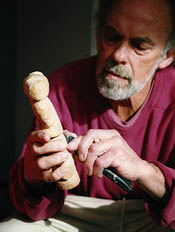 Graham carving (he was left-handed). At his home studio in Lime Grove, Bideford, c. 2005.
Graham carving (he was left-handed). At his home studio in Lime Grove, Bideford, c. 2005.
The following year, the family settled in Bideford, North Devon, invited by a friend from West Cork who had a house available for rent at no. 13 Lower Gunstone. Living in various locations around the town, and in the village of Westleigh, Graham explored his art further. To support his own creative work, Graham worked regularly as a part-time postman covering part of the seaside town of Appledore. For a time, he also took on the role of graphic designer, producing inventive posters and adverts inspired by Russian poster designs, for a community environmental project. Commissions included stage sets for a local dance school (which no longer survive). He worked in studios which included an outbuilding, a rented studio space, various domestic settings, and finally an upstairs room in their house at 42a Lime Grove, Bideford, which became his dedicated studio for fifteen years.
Graham's energy and thoughts were, alongside his artistic life, also taken up with family concerns. He was a compassionate and empathic Father, helping to care for Judith who became very ill for many years, attending to Una who had a car accident, and to the family which had expanded with grandchildren and then great-grandchildren all providing challenges and delight in equal measure. Graham later suffered physical setbacks himself, but he carried on producing work regardless with his wife Elizabeth's consistent support, before finally succumbing to cancer. This turmoil is evident in the artist's work, particularly in the abstract surreal drawings, produced during the early 1990s.
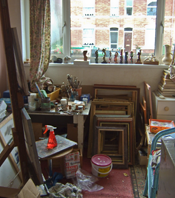 Graham's studio, June 2011.
Graham's studio, June 2011.
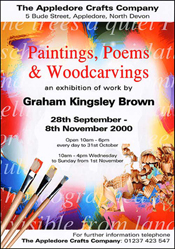 Poster for Graham's solo show "Paintings, Poems & Woodcarvings", designed by Graham's daughter Sophie Brown, 2000.
Poster for Graham's solo show "Paintings, Poems & Woodcarvings", designed by Graham's daughter Sophie Brown, 2000.
Artistic oeuvre
Graham's artistic oeuvre was truly multi-media. In the visual arts, he produced paintings (oil, acrylic), drawings, graphic designs and posters, painted tiles, decorated breadboards, stones, furniture, sculpture, carved in wood, created moulded ceramics, slate reliefs, and collage cut outs. He was also a regular writer, and loved poetry, producing poems, haikus, humourous pieces and philosophical thoughts, such as the "108 Partial Truths".
This body of artwork and poetry has, to date, been privately held. As a member of the Appledore Crafts Company for 4 years, Graham held a solo exhibition at the gallery in 2000, which included poem pieces and visual art work, and also exhibited some work locally in North Devon.
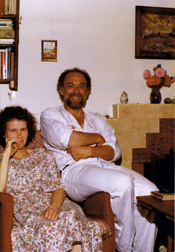 Graham and Elizabeth in Westleigh, Devon, c. 1976. Graham holding a poetry anthology which included his poem "The Gipsy".
Graham and Elizabeth in Westleigh, Devon, c. 1976. Graham holding a poetry anthology which included his poem "The Gipsy".
Theatrical Interests
Living in Westleigh village in 1978, Graham auditioned as an extra in the film "The Shout" with Alan Bates, John Hurt and Susannah York which was being part-filmed in the village. He was cast, appearing as the village churchgoer who provided continuity in the plot by being the character who turned his head to see John Hurt's character enter the Church. His daughter Una was also in the film as an extra playing in the street. Later, Graham's dramatic ability was put to use, in several roles he played as a talented and enthusiastic member of the Renaissance Theatre for some years, enjoying acting, and singing, to good effect, in several productions. His grand-daughter Lottie Beck Johnson has inherited a theatrical streak and has established an impressive repertoire with the National Youth Music Theatre, amongst others, and currently studying musical theatre.
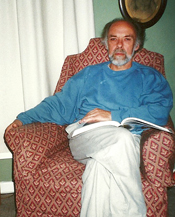 On holiday near Bath, on a visit to see his daughter Annabel.
On holiday near Bath, on a visit to see his daughter Annabel.
Summary
Graham was a truly diverse and entirely self-educated artist, an avid scholar of art history, poetry and metaphysical subjects, he produced works entirely from imagination.
He had a great sense of humour, was devoted to truth and to "the Creator", had prodigious imagination and energy to express that in his work. He was a proud, compassionate and loving father and grandfather, a man of strong views, who valued the freedom of the individual, was stoical, modest, and private, resulting in a reluctance to show his work. Even in his final months up to December 16th 2011, plans for new work that he wanted to do, were very much in his mind.
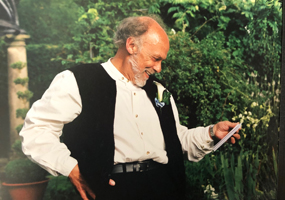 Graham reading his prepared speech (full of humour and meaning) at his daughter Una's wedding, 2002.
Graham reading his prepared speech (full of humour and meaning) at his daughter Una's wedding, 2002.
The works here collected span the years from 1965 to 2011 - but predominantly from the latter years where work is still available. They have never all been seen or shown as a body of work before.
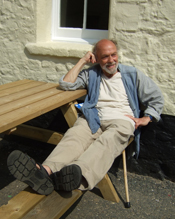 Relaxing at Hartland Quay, North Devon, on a day trip in May 2010.
Relaxing at Hartland Quay, North Devon, on a day trip in May 2010.
*Postcard by D. Noble of John Hinde Studios reproduced with Copyright holder's permission: ©John Hinde Archive
www.johnhindearchive.com